India: Zanskar – A Remote Buddhist World Tour Report 2022
3 January 2023

























































The kindness of the Zanskari people is immense. There is simply no such thing as feeling like a ‘stranger’ in this welcoming and open culture (image by Julie-Anne Davies)

Showing the 2500 meditation cave near the top of the image and Phugtal as it was built into the surrounding limestone cliffs (image by Julie-Anne Davies)

Early morning rooftop call to puja at Matho Monastery (image by Julie-Anne Davies)

Local women carry heavy loads of wheat during the harvest season at Parkachik (image by Julie-Anne Davies)

The riverside hike to Phugtal Monastery, deep in the Zanskar Valley (image by Julie-Anne Davies)

Yangdul, from Takmachik, in her gorgeous traditional turquoise Perak and Ladakhi dress (image by Julie-Anne Davies)

Reading glasses are always a welcome gift on our tours (image by Julie-Anne Davies)

Women of Takmachik working together to crush apricot shells. The outer shell is used as fuel for the coming winter, and the inner seed is harvested as an excellent healthy food source (image by Julie-Anne Davies)

Ladakhi villagers celebrating a local birthday on the outskirts of Takmachik (image by Julie-Anne Davies)

Padma Tsolmo, nomadic goat herder, outside her stone Nomad ‘home’ (image by Julie-Anne Davies)

Young Buddhist monks learn to read Tibetan scripture in their monastery classroom at Karsha (image by Julie-Anne Davies)

Thiksey, as seen from our lunch spot at a local family’s home (image by Julie-Anne Davies)

An elderly Brokpa woman in the village of Darchik, Aryan Valley (image by Julie-Anne Davies)

A mother and her young child, out for an evening walk in the fields of Zangla (image by Julie-Anne Davies)

Padma Tsolmo invited us inside her stone home to see how she lives firsthand and it was fascinating (image by Julie-Anne Davies)

Portrait of a traditional Brokpa woman in Garkon (image by Julie-Anne Davies)

Monks playing the large Dung Chen horns at the 5:30am ‘Call to puja’ on the rooftop of Karsha Monastery, with the wide open Padum farmlands below (image by Julie-Anne Davies)

A Muslim woman working in her barley and wheat field on outskirts of Kargil (image by Julie-Anne Davies)

Harvest time at Parkachik (image by Julie-Anne Davies)

The hand of the 80 year old Rangdum Lama and his mala beads, constantly chanting om-mani-padme-hum as we visited (image by Julie-Anne Davies)

A friendly local Zanskari at Rangdum (image by Julie-Anne Davies)

A local Muslim girl in her beautiful ‘Abaya’ or hooded cloak, at Kargil (image by Julie-Anne Davies)

Serene portrait of a pretty Zangla nun (image by Julie-Anne Davies)

Local Woman crushing apricots in Takmachik (image by Julie-Anne Davies)

Despite their heavy work, the people of Parkachik still laugh and smile during the harvest season (image by Julie-Anne Davies)

Our gracious hosts in their home and traditional Zanskari clothing (image by Julie-Anne Davies)

We distributed several pairs of reading glasses to local elders during our tour (image by Julie-Anne Davies)

These goats have seen better days… A common scene in the Kargil markets (image by Julie-Anne Davies)

The Drang Drung Glacier as viewed from 14,400 ft Pensi La Pass. Signs of change at the bottom of the image, as construction of the Zanskar road continues (image by Julie-Anne Davies)

Young Islamic school children, lined up from tallest to shortest, begin their day with the Muslim Call to Prayer at Parkachik (image by Julie-Anne Davies)

It's wise to keep warm as the winter approaches the Zanskar (image by Julie-Anne Davies)

Young monks arriving for early morning puja at Karsha Monastery (image by Julie-Anne Davies)

Young monks laugh together at Karsha Monastery (image by Julie-Anne Davies)

Friendly locals on the streets of Kargil (image by Julie-Anne Davies)

Locals are working hard to prepare and store the harvest for the coming winter months (image by Julie-Anne Davies)

An elderly Ladakhi woman spins her mani wheel and chants Om Mani Padme Hum at Takmachik (image by Julie-Anne Davies)

Karsha Monastery clings to cliff face on outskirts of Padum (image by Julie-Anne Davies)

Traditional Ladakhi shoes during village celebration near Takmachik (image by Julie-Anne Davies)

Leh from high above town at the Leh Palace, looking across to the Shanti Stupa at sunset. The Stupa was built in 1985 to promote world peace and commemorate 2500 years of Buddhism (image by Julie-Anne Davies)

Our ‘tent’ home for the night on the outskirts of Rangdum (Rangdum Monastery in the background at the base of the mountain on the right). Our cozy tents came complete with hot showers and a flushing toilet! (image by Julie-Anne Davies)

The warm smile of an elderly lady at Anmu village (image by Julie-Anne Davies)

Smiling Padma Tsolmo in Zanskar (image by Julie-Anne Davies)

Tsering Wang Chuk, a Karsha monk, smiling inside the Monastery (image by Julie-Anne Davies)

A Zanskari woman carrying a basket on her way home from the local market at Padum (image by Julie-Anne Davies)

The stunning hike alongside the Tserap River en-route to Phugtal (image by Julie-Anne Davies)

A Phugtal monk deep in prayer during puja (image by Julie-Anne Davies)

Kargil architecture is a fascinating mix of old and new (image by Julie-Anne Davies)

The view from up high inside Phugtal, looking back at the direction of our hike and our sleeping quarters for the night (image by Julie-Anne Davies)

A young Phugtal monk bundled up for early morning puja (image by Julie-Anne Davies)

Phugtal Monastery, built around a 2500-year-old cave has a history of mystics, Buddhists, scholars and gurus (image by Julie-Anne Davies)

The young monks of Phugtal at their morning school session, just below the cave, high in the monastery (image by Julie-Anne Davies)

Our guide KC’s wonderful parents, Tashi Lazom and Rigzin Dawa, inside their home in Zangla (image by Julie-Anne Davies)

A local Zanskari woman and her granddaughter washing clothing together at Cha Village (image by Julie-Anne Davies)

A smiling Zangla nun from the monastery of the same name in Zanskar (image by Julie-Anne Davies)

Handmade traditional ‘Hanging Bridge’ en-route to Phugtal. Our group didn't have to cross it! (image by Julie-Anne Davies)
Leh: Monasteries, Monks and Markets
Arrival by air into Leh at 11,562ft deserves the same respect and guidelines no matter how many times you visit. The thin air of the Buddhist Blue Sky kingdom means your body needs to take time to acclimate. Day one reflects this necessity and we began our tour with a gentle stroll around the Leh Markets, chatting with locals, warming up our street photography skills and sipping on chai lattes in Leh Old Town. Our low key agenda allowed for our bodies to adjust to the physiological changes we would need to enjoy our high altitude adventure over the next two weeks.
We awoke early the next morning not only to our alarms, but to the Islamic Call to Prayer echoing off the surrounding hillsides of Leh, reminding us that we were in a land of thick cultural and religious diversity – one where Buddhist, Sikh, Hindu, Muslim and ancient tribal groups coexist under the same blue sky. We set off in the crisp morning air, hoping to arrive at the hilltop Matho monastery in time to witness the Buddhist monks arriving for morning puja, or daily prayer. We climbed the stairs to the monastery rooftop to witness our first of many ancient Buddhist traditions. A monk stood alone, framed by a backdrop of golden fields and jagged Himalayan skyline. Gently but repeatedly, he hit a large Tibetan cymbal, sending reverberations into the surrounding thin air, summoning the other monks to the temple hall for morning prayer. Inside the temple, we sat cross legged and silent, as the room filled with the low tones of monks chanting Buddhist scriptures in unison. The jangle of ancient handmade bells, Tibetan horns and goat skin drums was mesmerizing. The air felt less ‘thin’ with the heavy scent of burning incense and butter tea as it passed from monk to monk and eventually to us, the observers. We were made to feel welcome and not just as outsiders looking in. A young monk tore pieces of fresh baked Tibetan bread, handing us each a portion, bowing slightly as he did so, quietly whispering ‘Jullay’ as if to thank us for being there. We would experience this same sense of acceptance, hospitality and peace many times over the next few weeks. As puja concluded, each monk shuffled out, taking turns first to kneel down, touching their forehead to the floor and praying to the large Buddha at the head of the temple. The Lama, or head monk, stayed behind asking if he could share a few words with us. We sat quietly while he spoke about compassion, kindness and acceptance in both Ladakhi and broken English. KC translated while we listened to the lessons the lama had to share. It was a very memorable and moving way to begin our journey.
Thiksey – Lamayuru – Kargil
We visited the ancient Thiksey monastery and Shey Palace later that same day, stopping for the first of many lunches that would be graciously served to us in a locals’ home. We caught word that the Thiksey monks had been working for months on a ‘sand mandala’ – an ancient Buddhist tradition of creating an elaborate Tibetan design with colorful grains of sand, only to ceremoniously destroy the creation as a way of affirming the ‘impermanence of all things’. A gathering of monks from the local monasteries was planned for 6am the next morning, so we returned at sunrise to witness the young monks summon the gathering with their long Tibetan horns and conch. Down in the temple, we sipped salty tea and watched as 60 or so monks arrived, one by one, to the temple hall to join in the start of the mandala celebration before setting off from Leh on our first steps northeast, towards the head of the remote Zanskar Valley.
Several hours later, following the Indus as it flowed north, we wound our way through the high desert plateau and parallel ranges that separate the Indus from the Nubra Valley to the east and the Zanskar to the west. We stopped briefly to photograph the confluence of the Indus and Zanskar rivers at Nimoo before crossing the Indus and entering the narrow gorge leading to the moonscapes of 11th century Lamayuru, Ladakh’s oldest monastery. The field’s leading up to the monastery were dotted with locals, some loading and packing freshly cut wheat, others clustered together, young and old, picnicking in the shade. Lamayuru monastery was eerily quiet and it wasn’t until we stopped at a lookout on our drive away from the village that we realized why. Three truck loads of ochre robed young monks were singing and laughing enroute back to the monastery, having spent a rare day out picnicking by a local river. Sorry to have missed them, but witnessing their sheer joy and sense of jovial freedom as they hung off the sides and back of the trucks made up for it.
We continued on our way through the barren landscapes, past tiny villages and over a handful of high passes, shrouded with prayer flags, worn and faded from the elements over the decades, arriving in predominantly Muslim Kargil as night fell. After a buffet dinner of Kashmiri and Indian curries, we headed out for a stroll to meet the nearby locals and play around with some low light techniques and street photography.
Into the Zanskar
Our route led southeast from Kargil along a narrow, winding willow lined highway. Running parallel were fields ripe with wheat, barley and mustard harvest, stretching beyond the roadway and down to the banks of the Suru River. We stopped to meet and photograph locals working the fields as KC translated effortlessly, facilitating our conversations. A few hours from Kargil, our route took a southerly turn, crossing the Suru River and officially departing from the road to Srinagar, driving on what was until recently the only way in and out of the mystical Zanskar Valley. The topography began to stiffen, with peaks reaching further towards the sky and alpine meadows sweeping upwards, red autumn foliage exposed until covered by hanging glaciers from above.
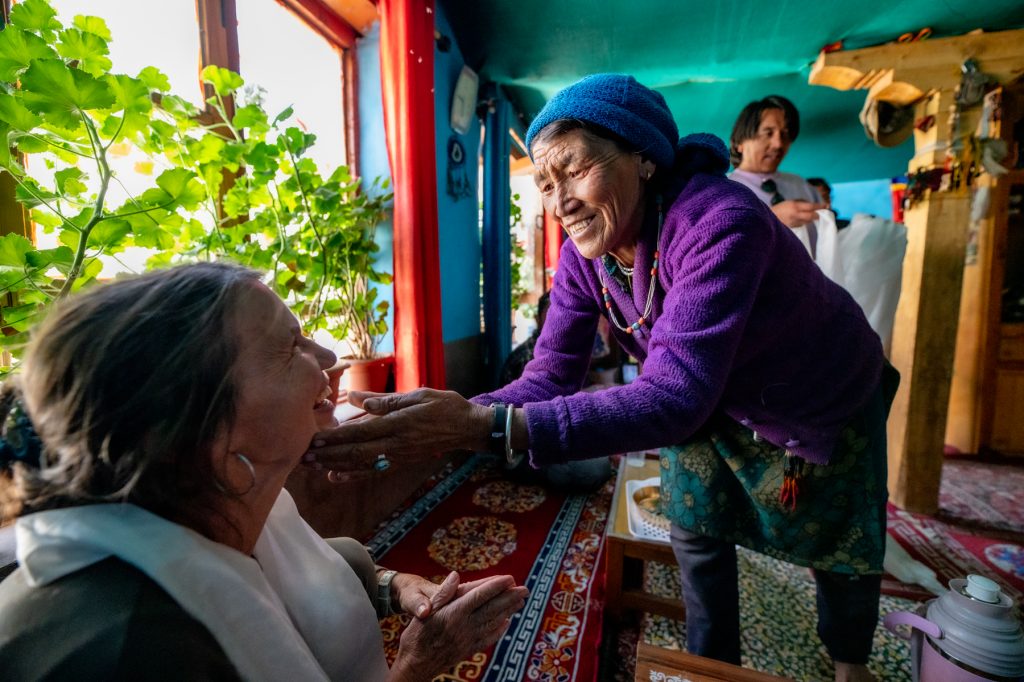
Treated like old friends or long-lost family. Zanskari hospitality and kindness are legendary (image by Julie-Anne Davies)
The first Buddhist influences arrived in Zanskar possibly as early as 200 BC, filtering in from Kashmir. Accessible only by foot and long, arduous journeys, the Zanskar lay relatively inaccessible to the outside world until the construction of this exact road we were driving on, from Kargil to Padum, in 1972. Mystics, scholars and gurus journeyed here, one of the most remote inhabited places on earth and until less than 50 years ago, thousands of years of Buddhist culture remained sheltered in this Shangri-La from modernity or outside influence.The pace in which change is occurring in the Zanskar is like a tidal wave happening in only a teaspoon of time.
The road shifted from gravel to sections of fresh pavement recently applied by Indian road crews, and then back to gravel. The only constant was the unbroken chain of stunning landscapes, as we made our way deeper into the heart of the valley. Vast golden meadows were dotted by straw roofed clay homes and extensive networks of stone fencing. Ancient footpaths carved across nearly every slope, connecting the dots and serving, until a few decades ago as the life line that tied the Zanskari people to one another. Nomadic people have walked these paths for thousands of years and still do today. Our first encounter with a group of these nomads happened a few hours into our drive from Kargil. Five Kashmiri nomads and their herd of several hundred goats and horses were boiling goat milk and spices for tea when we approached waving a bag of dried apricots as our way of communicating that we would like to have a visit. They assured us it was ok to join them through smiles and hand gestures, so we climbed the hillside to their encampment that consisted of one small stone shelter, a fire and their cooking supplies. Through laughter, a rudimentary form of Charades and KC’s translations, we sat together communicating and sipping freshly brewed goat milk. We learned that they had been walking the open high plains of Zanskar for months while their goats grazed and it was time, as autumn neared, to head back to Kashmir with the herd to spend the long cold winter months. They accepted our apricots and allowed us to make a few portraits. These are the moments that make all the difference in a journey – when we are able to simply sit and be present with the local culture in their authentic daily life.
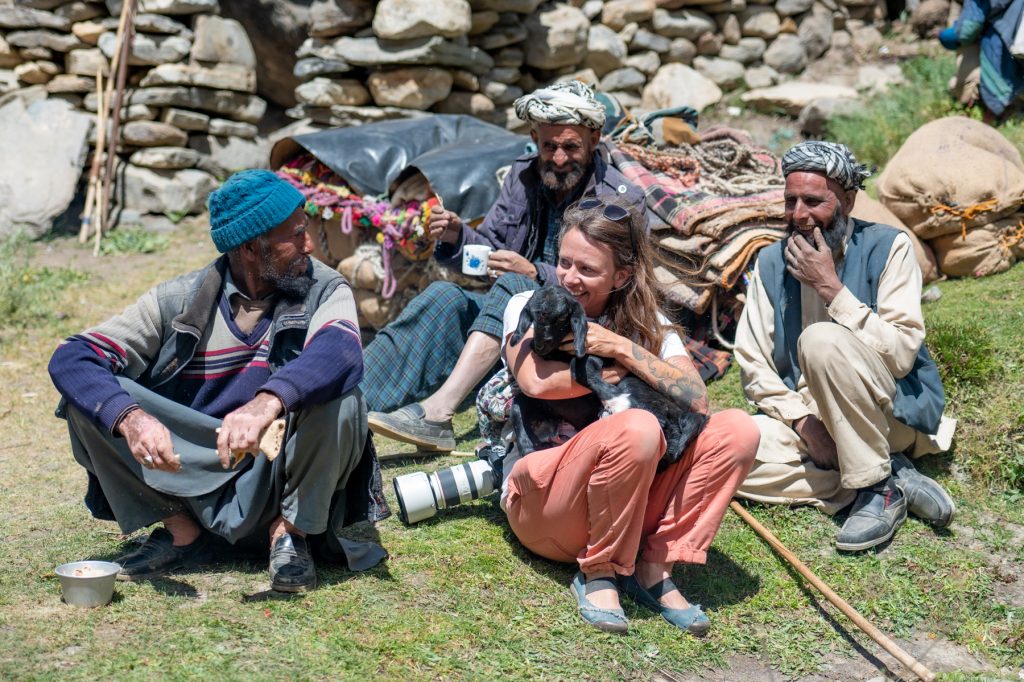
Our first meeting and tea with Nomads. Nomadic goat herders on the way up to Pensi La Pass (image by Julie-Anne Davies)
We continued on for several hours before reaching the ‘height of land’ at Penzi La Pass at 14,400ft and the ‘official’ entrance to the Zanskar Valley. The award upon reaching the thinnest air of the trip was the view of the largest glacier in Ladakh, the Drang Drung glacier, as it winds down and south, from heights of 20,000+ feet. It is the headwaters of the Doda, one of the main tributaries of the mighty Zanskar River. We made our way down the steep gravel ‘road’ and continued south towards Rangdum and finally, by nightfall, we reached Padum.
Padum – Karsha – Zangla
Padum, named after the Buddhist guru Padmasambahva, is the administrative capital of Zanskar and the center point from which the three main valley’s of the Zanskar flow. To the north and east is the Sham Valley and mighty Zanskar River, to the west and south runs the narrow Lugnak Valley and the Tserap River, and to the North towards Kargil, from which we had come, the beautiful Stod Valley and Doda River.
We were up before the break of dawn to make our way to nearby Karsha Monastery and to witness another sunrise rooftop ‘call’ to morning prayer. A short drive through ripe barley and wheat fields led us to the steep hillside where Karsha, the largest monastery in the Zanskar, sits tightly carved into the mountainside, its winding rock staircases leading upward, worn by 1000 years of continuous inhabitation. We stood, listening and photographing three young monks as they were warmed by the first light of the day on the clay roofed temple, sounding out their Tibetan horns, framed by a surreal backdrop of Himalayan peaks and hanging glaciers. Little monks emerged sleepy-eyed and made their way up from their dormitory to the main temple. We joined them for puja and tea and then left with them after an hour or so, invited to come to their classroom to witness their school life, which consisted of Tibetan reading/writing lessons, philosophy and Buddhist history among the usual subjects.
It was difficult to say goodbye to Karsha, but by noon, we headed further into the Sham Valley, stopping next at the ancient Stongde Monastery. Perched at the top of a small cone shaped mountain, access to Stongde was, until recently, via a foot or mule path straight up the steep rocky slopes from valley bottom. A road now carves around the backside of the mountain and within 10 mins one can park at the top and visit with relative ease. The views from Stongde out across the high plains back towards Padum were just what I had always envisioned Zanskar to be. Golden wheat crops and smatterings of tiny clay homes in villages circled by ancient hand built stone fences, wide sweeping pristine mountain valleys that stretched out and upwards so high towards the sky, that the sun’s light shone in long hazy beams through saddles from behind their impossibly tall ridge tops.
We left Stongde and headed towards the ‘end of the road’ in the Sham Valley, or Zangla, the once ‘Royal Village of Zanskar’. Our guide KC grew up in Zangla and is a direct descendant of the royal family and even bares the title of ‘Prince of Zangla’. With his faded Levis, Metallica t-shirt and grey hoodie, he plays the part modestly, at least visually. But royalty he certainly is, as KC is without doubt one of the kindest and most caring people you could meet. He was a perfect guide for this trip in that he knew Zanskar intimately, was passionate about sharing his love for Ladakh and has a heart of solid gold, so there wasn’t a moment we did not feel cared for or uneasy. Meeting his family in Zangla was a highlight of the trip. We spent the night in his home, fed literally like royalty to a feast of traditional Zanskari dishes and a very cozy night sleep in his newly built ‘guest quarters’.
Before dinner we had made our way up to the Zangla Nunnery. Tucked into the hillside at the far end of Zangla is the Changchub Choling. Roughly 25 nuns, between the ages of 5 and 65 welcomed us with wide open arms that by now we were recognizing as the typical demeanor of the Zanskari people, only even more so here, with smiles and laughter at a level we had not yet encountered until this point in our tour. What a beautiful, welcoming energy these ladies had, young and old. It wasn’t surprising to us when after even only a few hours of visiting that our departure caused a few of the young nuns to shed some tears.
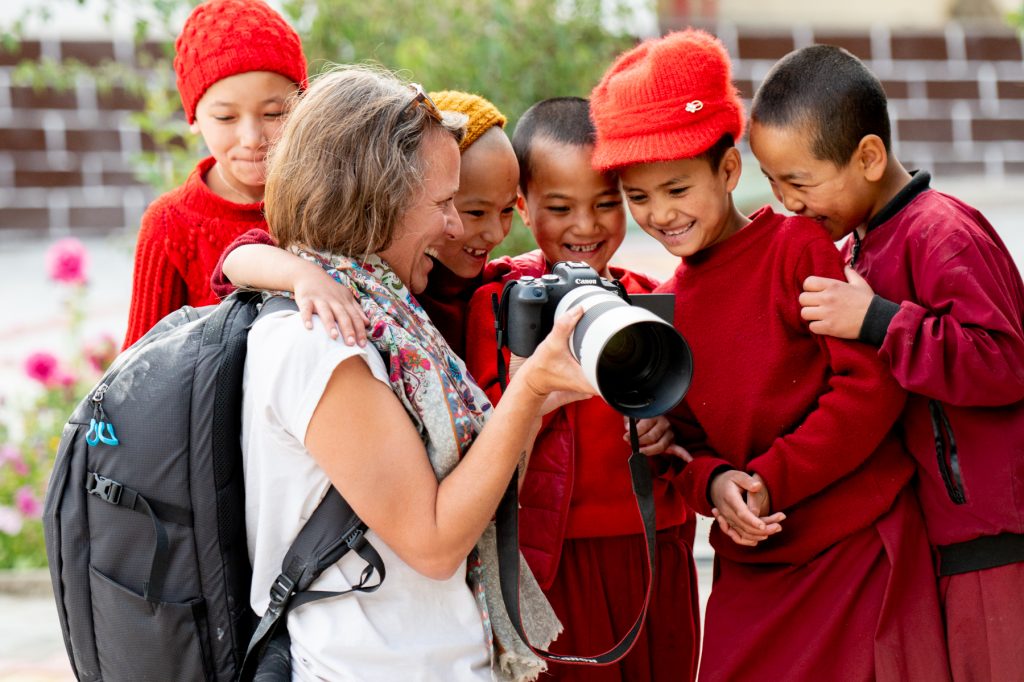
A Wild Images guest in her element with a crew of happy young nuns. Zangla Nunnery (image by Julie-Anne Davies)
There was just enough light left in our day to wander through and experience the rural ‘nightlife’ of Zangla. There were groups of children running wild at dusk, granny’s walking the fields reprimanding their young cows who had not come in when called, mother’s out walking and rocking their babies to sleep, elders spinning their hand held mani wheels and chatting about the speed of the changes they were witnessing in their world – we watched, as a community relatively still unaffected by modernity played out it’s evening rituals.
Zangla – Phugtal
Knowing that the temperatures were forecast to be higher than average for this time of year and that our two hour hike into the remote Phugtal Monastery had very little natural shade, we opted to leave Zangla as early as reasonably possible the next morning. We passed once again through the hub, Padum, and headed this time SE, driving upstream alongside the Tserap River and into the narrow Lugnak Valley. For several hours, we drove a narrow dirt roadway carved into the valley above the river, passing by small villages and hanging bridges, many tenuously clinging to life from high water damage and years of use. By midmorning we had reached the literal ‘end of the road’. We had driven as far as we could along the Tserap river and the road culminated at the head of a narrowing section of the gorge. We would load our gear onto horses and walk almost two hours from here, along a hand built pathway hugging the edge of the fast moving Tserap, just as Buddhists, mystics and sages had done for the last 2500 years. The only indication of modernity along the pathway leading to Phugtal was the newly installed robust metal bridge that spanned the Tserap just meters downstream from the traditional hand woven wooden bridge, intricate to begin with and worn by years of ferrying loads of supplies into Phugtal.
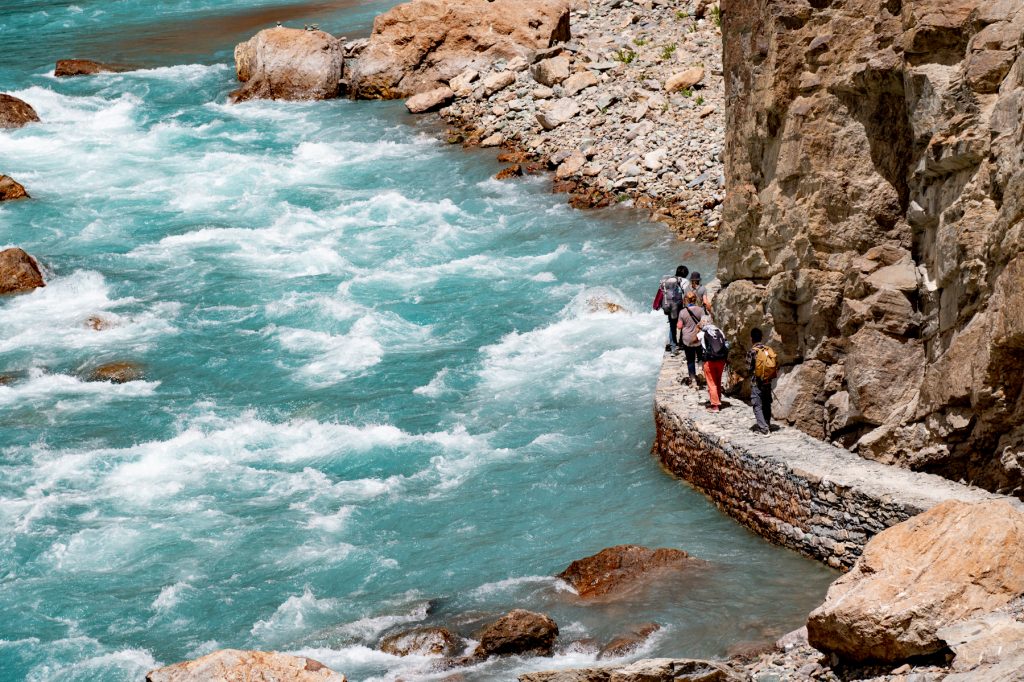
The riverside hike to Phugtal Monastery, deep in the Zanskar Valley (image by Julie-Anne Davies)
Only 10 or so minutes past the bridge, we rounded the corner to our very first glimpse of Phugtal. It was like something out of a story book or a fairytale from middle earth – a sight that burns itself into the memory of the onlooker. Built around a cave high on the cliff face above the river, it seemed to hang in the air, accessed by a steep trail and ancient stone staircases. Phugtal has a 2500 year history, believed to have begun with the legendary followers of Buddha, the 16 Arhats, who came to the cave to meditate, along with mystics and sages throughout time. The remote location of the monastery was ideal for monks looking for peace and solitude. The present Phuktal Gompa, of the Gelug school of Tibetan Buddhism, was established in the early 15th century by Jangsem Sherap Zangpo. We arrived in time for evening Puja and made our way up the almost vertical staircase, watching our every step as we went, as young red robed monks ran past, giggling, almost seemingly unaware of our presence or the steepness of the stairs. Breathless by the time we reached the top of the monastery, we were welcomed into the main temple and swiftly found our place, along the edges of the hall, cross legged once more, as the monks began their chants. Monks in ages ranging from 5 to 85 swayed methodically together, repeating deeply toned Tibetan scriptures in the form of a melody, over and over, broken only by their momentary switch to sounding horns, cymbals and drums – a pattern repeated sometimes for hours, both morning and night. We watched, as the young monks fled the temple hall to diligently assemble for their morning school session. Several of the older boys performed the chore of preparing a meal for the entire monastery, cutting vegetables on a rudimentary chopping block on the floor of an 800 year old kitchen, walls carved out of limestone and blackened by almost a thousand years of cooking with wood and oil for fuel. Following several hours of exploration within the monastery, we descended back down the winding staircase and hillside to our rooms in a kind of guest quarter that was run, built and maintained by the Phugtal monks to house those who made the trek to the remote monastery.
We rose early the next morning for one more puja and butter tea with the Phugtal monks and began our hike out shortly after downing the usual masala omelet and tea for breakfast. Hiking along the Tserap in the cooler hours of the day was a treat and we made the trek in almost half the time it took to walk in during the heat the day before. Each step towards the van felt like a step back towards the present day, leaving the young and old Phugtal monks to their sacred home still so largely untouched from modernity and the world at large. It was heartbreaking to hear that there is a plan to build a road all the way to Phugtal within the next few years. The hike in is not difficult and still helps to maintain some of the very sacred and remote space that preserves the integrity of the rare and beautiful place that Phugtal is.
Back at the trailhead, we unloaded our gear from horseback and into the van, thankful to have experienced this ancient and special place before the world arrives in droves on its doorstep. It was time to begin the retracing of our steps. We had made it to the furthest point at which we could go into the Zanskar Valley and today, we would begin our journey back to where we began.
Cha – Rangdum
One of the best rewards of ‘out of back’ mountain travel is that when you turn around to head ‘home’, the view is completely different than on the way in. The drive from the ‘end of the road’ back towards Padum was no exception to this rule and we took our time to stop in several villages to meet the locals and hand out a few more bags of apricots. Cha was the first stop on our return trip, high on a dry mid-elevation plateau, perched on sheer clay walls above the Tserap River but below the bony and barren 13,000ft rock slopes above. Cha has about 30 homes and traditionally rich fields that have been suffering as of late from recent droughts and little to no fresh snow in the recent winters. We met a family washing their clothing by hand. The grandmother, mother and 3 year old granddaughter all working hard, and most importantly, together. Other villagers approached and we spent a few hours in translated conversation alongside them, just witnessing, photographing and sharing in the local happenings, laughing together as the hot afternoon passed.
Continuing down the road in the search for a shady afternoon picnic stop, we took a narrow pathway hardly wide enough for the van into the small and peaceful village of Anmu. On the same narrow mid-elevation ledge above the Tserap that Cha clings to, Anmu’s saving grace were its shade trees and spring water that runs through the heart of the small village that was occupied by only a handful of families, yaks and thriving gardens. While KC and the crew prepared another fabulous roadside picnic of freshly steamed vegetables, rice and soup, we met and chatted with two local elders. It was the perfect opportunity to pull out the collection of reading glasses that one of our guests, Christine, had carried all the way from home to give to those in need.
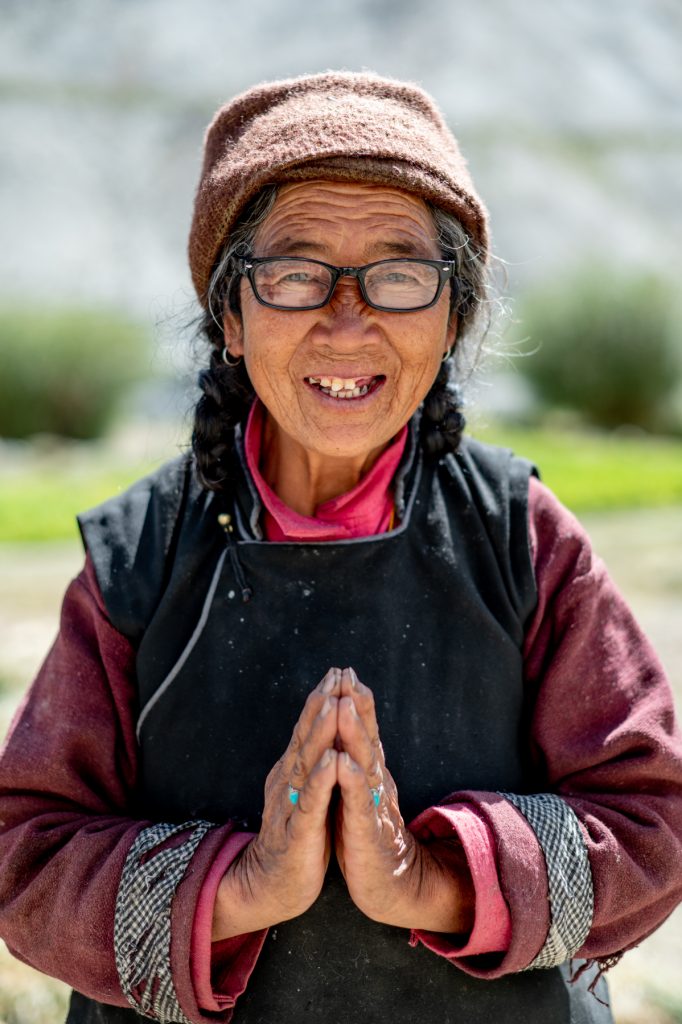
We distributed several pairs of reading glasses to local elders during our tour (image by Julie-Anne Davies)
A few hours further down the road we reached the stunning 17th century Bardan Monastery. Perched on a natural pinnacle, Bardan’s setting, rising high above the Lugnak River is one of the more iconic monastery settings in Zanskar and acts as a symbolic gateway into and out of the Lugnak Valley. We were back in Padum by nightfall after a full day of travel in a once timeless and tightly tucked away valley.
Our journey northward began again early the next day, but stopped not far from Padum with a visit to a local family’s home – an unscheduled stop, but a truly memorable one. We were at the home of a friend’s mother, and although I had not yet met this woman, she welcomed us into her home as if we were long lost family. We were treated to a traditional lunch and capped off our visit dancing and laughing together. She dressed in her traditional Zanskari clothes for us – Tibi and Bok, pointed felt shoes and yak wool shawl and allowed us to document the moment.
Back on the road, we made a solid day’s push towards Rangdum, stopping for another memorable encounter just shy of the Penzi La Pass. Spotting a few rock structures and a herd of goats, we stopped to see if there were any nomads occupying the camp. There were three nomadic women inhabiting the rock homes, two of whom had just left to roam the vast lands below the camp, gathering their herds before nightfall. One nomadic woman, Padma Tsolmo, graciously invited us into her home to witness first hand the interior of her tiny natural space, complete with pellet stove, pots, pans, Tsampa, goat milk, pashmina rugs and dried goat meat. She allowed us to photograph her fascinating world and offered us butter tea – we gave her a few bags of dried apricots for her hospitality, our way of thanking her for offering us a chance to witness Nomadic life up close.
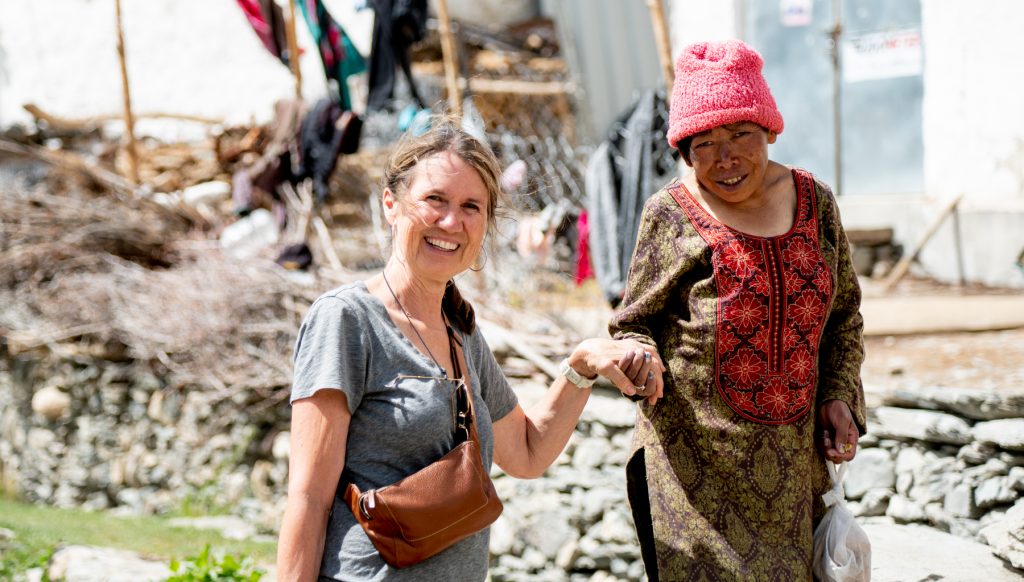
One of the most rewarding aspects of travel is meeting and connecting with locals (image by Julie-Anne Davies)
Passing again through spectacular Pensi La Pass, we descended towards Rangdum and away from the deepest reaches of the mystical Zanskar. Late in the day, we paid a visit to the Rangdum Monastery, meeting and chatting with an 80 year old monk who had spent his entire life in the valley, sharing his smiles and few words with us in between his chants of om-mani-padme-hum and the twirling of his prayer beads between his fingers. Our ‘home’ for the night was an interesting and surprisingly upscale tent camp on the outskirts of Rangdum. We each had our own tent, complete with a shower and flush toilet, right smack on the edge of a vast open tundra. The cool starry night made comfortable by multiple large duvets and thick mattresses.
Rangdum – Garkon
Following a crisp and early breakfast of Masala tea and Tsampa porridge the next morning, we were off again, heading towards the boundary of where Muslim culture begins to replace the predominantly Buddhist lands of the main Zanskar. Parkachik, a lush and productive Muslim enclave at the foot of the Gangri Glacier, sits in the shadow of 23,400 ft Nun Kun Massif. Its inhabitants are hard working Muslim farming families and we were passing through at the height of harvest season. Other than the uniformed school children lined up tightly in morning prayer in the school courtyard, the entire community seemed to be actively participating in the communal harvest. Women and men, young and old, had loads several times the size of their own bodies of freshly cut wheat and barley strapped to their backs, some using a tump line across their foreheads to aid in distributing the weight of such a heavy load.
By late afternoon we reached Kargil, where we should have been ready to retire to our comfortable hotel room after our long drive, but instead we opted to explore the streets of the main market, photographing a relatively small but fascinating glimpse into the local culture. There were women dressed head to toe in gorgeous brightly coloured Abaya’s (hooded Islamic cloaks), men with chest length henna dyed crimson beards, carts with rickety wooden wheels alongside the latest model Suzukis. The Call to Prayer echoed throughout the streets from central gold laced mosque towers competing for airspace amidst the hip hop tunes of Levi and Nike clad teens. Young men clustered arm in arm on street corners, selling roasted corn and spices. Goat heads and lamb momos sizzling over open fires beside tiny seamstress stalls stitching together the latest hand spun wool and freshly dyed cotton fabrics. Kargil is a fascinating microcosm of where Muslim life sits in today’s world – one hand rooted deeply in the traditions of the past, the other placed firmly on the rapidly modernizing global reality.
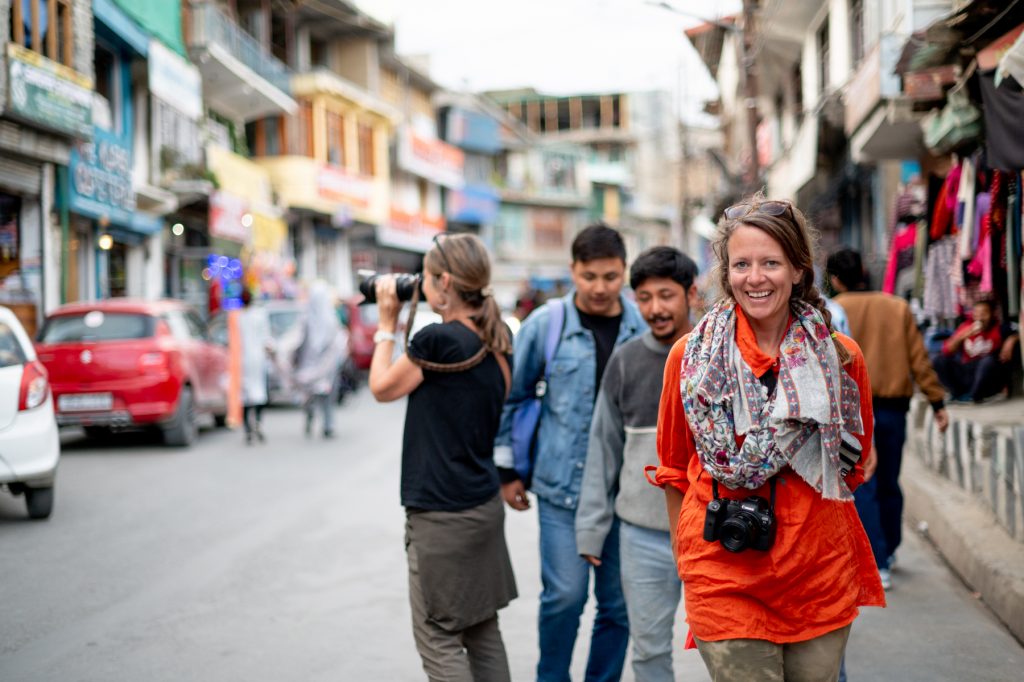
Enjoying the vibrant energy and photogenic nature of the local markets in Kargil (image by Julie-Anne Davies)
The next morning we made one stop in the local market to purchase Kashmiri tea as gifts for the Brokpa people we would be meeting that afternoon. We headed upwards and east out of Kargil on a secondary road leading into the tightly walled Aryan Valley – a valley with 5000 years of history, etched deeply into this lush drainage and sparsely populated by tribal communities. There are only five Brokpa communities remaining today, four of which are right here, spread a handful of kms from one another along the narrow and winding river valley. The approximately 1800 remaining Brokpa believe they are the direct descendants of Alexander the Great’s army from when he abandoned their mission in 326 BC on the banks of the Indus. There is no doubt that they are a genetically distinct group of people, typically tall, with high cheekbones and long sleek noses and olive shaped eyes. But whether or not the Brokpa are of a pure Aryan bloodline, there is much debate and there has never been a definitively conclusive study. They are considered Buddhists, but practice a form of animistic worship referred to as Bon, or nature worship that predates Buddhism. They dress with wildly colorful headgear of dried flowers, coins and thick goat skin wool lined shawls. Until only a few decades ago, traveling outside one’s community was unheard of in the Brokpa world and they practice, still to this day, endogamy, or marriage strictly within the Brokpa lineage only.
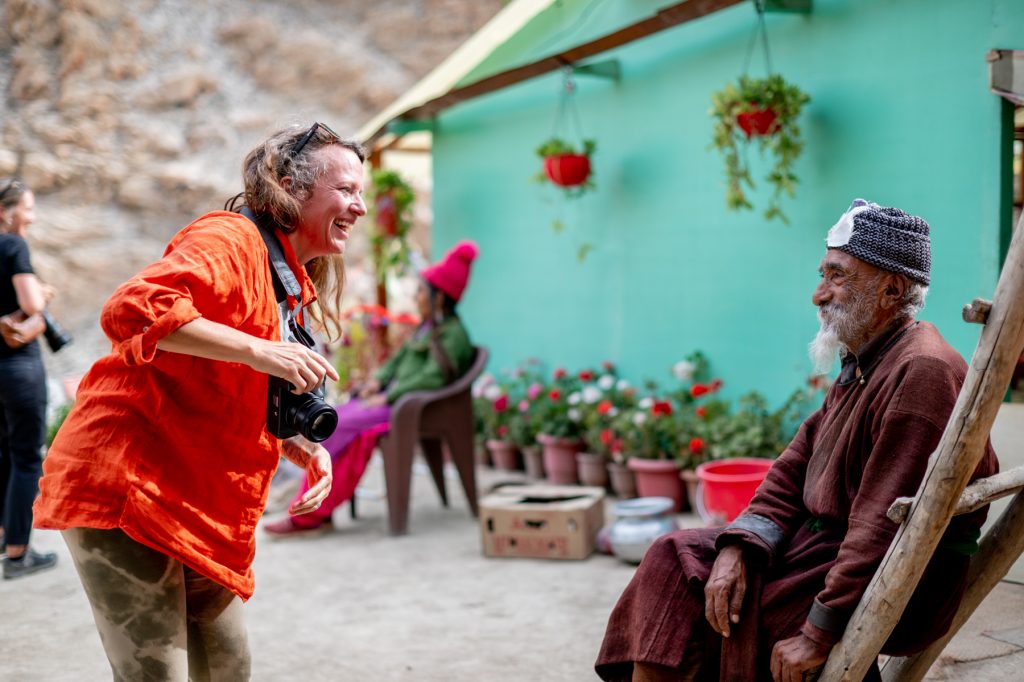
Spending time with Brokpa elders, Garkon (image by Julie-Anne Davies)
We first stopped at Darchik on the west side of the Indus River and then Garkon, further upstream on the east side of the Indus. A great deal of change had occurred in both of these idyllic communities since my last visit three years prior. Roads now existed in place of ancient old growth apricot trees, pushed deep into the heart of each village. Intricate water canals that ran alongside fields that have, for thousands of years, organically sustained Brokpa life have been redirected into pipes. Times are changing at a lightning pace for the Brokpa people. The elders are still there, numerous, but dwindling. Those living a truly traditional life in the Aryan Valley are becoming fewer and farther between now and the bond that has, for time immemorial, connected them to one another is beginning to unravel as a result of technological and hence, social changes that cause younger generations from opposite ends of the world to have more in common with one another than they do with their own immediate families. Efforts to preserve cultural heritage and way of life in the Brokpa world are up against a very strong tide, which makes efforts to visually document what still remains even more important. We spent two days with the Brokpa, mainly in Garkon Village, watching as the women sat together crushing apricot seeds, keeping the outer shell for fuel and the inner seed for a variety of uses during the coming winter. We sat chatting with a man and his wife, as they harvested seeds and a group of Brokpa grandparents as they played with their young grandchildren. The intricate knowledge, way of life and ancient connections with the land that the Brokpa have sustained themselves on for thousands of years can only survive if it is passed from these vanishing elders and onto these children in comprehensive and meaningful ways.
Aryan Valley – Alchi – Leh
We parted ways from our Aryan hosts and began driving south in the late morning, headed for the stunning organic village of Takmachik for lunch. Nestled into the West Bank of the valley, not far north from where the Zanskar River pours wildly into the Indus, Takmachik thrives as a model ‘Eco-Village’ and sustainable self-sufficient community, in both farming and traditional ways of life. Our partner in Ladakh, Jigmet Dadul and his family have deep roots in Takmachik and we spent our afternoon feasting on traditional Ladakhi dishes, laughing together and photographing his mother Yangdul and several other local women in their traditional attire. Using an abandoned but still accessible traditional home as the backdrop for our shoot, Yangdul and her friends donned their heirloom turquoise Peraks, yak wool shawls, jewelry and felt shoes for us to capture in an authentic but slowly dilapidating setting.
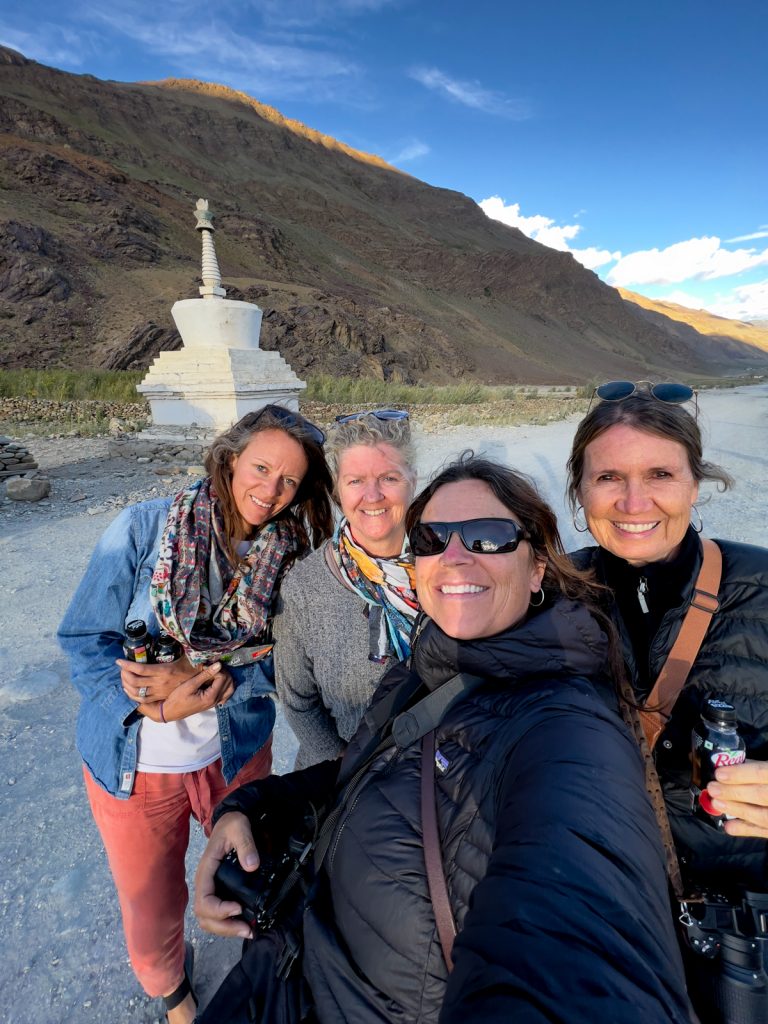
Our Wild Images group looking very happy during their exploration of the heavenly Zanskar (image by Julie-Anne Davies)
We caught word that a community celebration was taking place just down the road from Takmachik and decided to stop in, assured by our guide KC that in the classic Ladakhi open-armed way, we would be more than welcome to simply arrive and participate in the going-ons. About 150 young and old Ladakhis had arrived that afternoon from nearby villages to celebrate a local birthday. Almost everyone was dressed in their finest traditional attire, dancing to the brassy sounds of Tibetan horns and rhythm of goat skinned drums. There was no shortage of Chang consumption (rice wine) and carefree laughter. The photo opportunities were endless, largely Chang induced, as everyone seemed more than happy to interact with us and our cameras. A very casual and open setting and great opportunity to witness traditional village festivities.
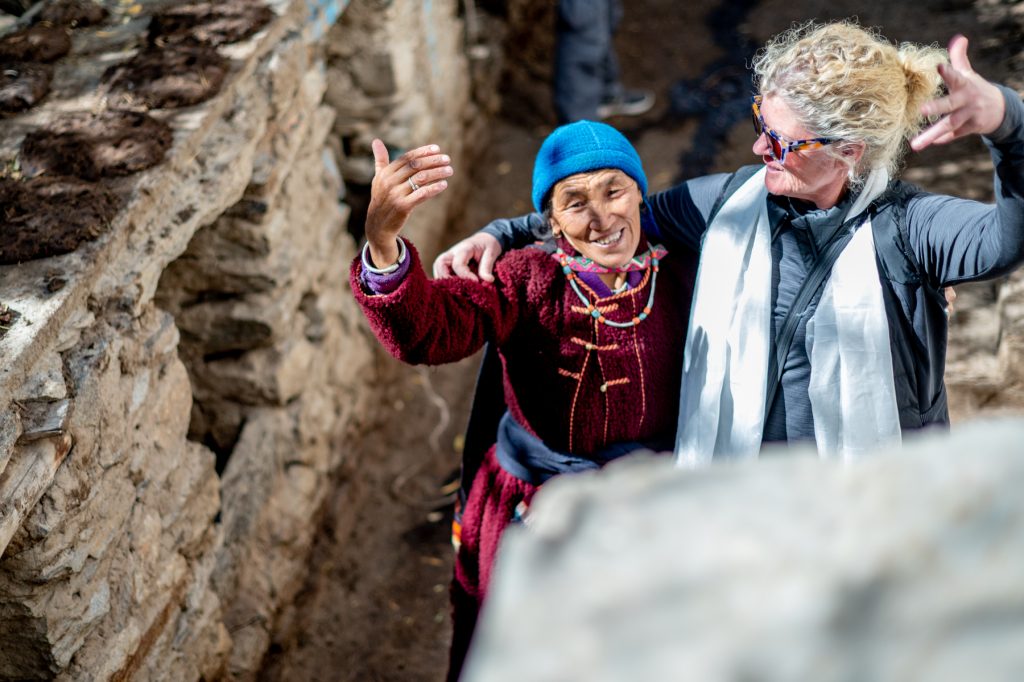
Dancing and laughing with the locals as our group says goodbye (image by Julie-Anne Davies)
Our last evening ‘on the road’ would be spent at Alchi, one of the oldest monasteries in Ladakh, dating back to 958AD. Wall paintings inside the monastery reflect stories and details from both Buddhist and Hindu influences and are some of the oldest surviving paintings in Ladakh. An evening stroll through the fields surrounding Alchi, followed by a dinner of curry, naan and a cozy room overlooking the mountains was the perfect combination for our last night ‘on the road’. The next morning we were up early and heading back – full circle – to Leh, where our immersive and beautiful journey had begun. We ended our time together with what might very well be one of the best buffets in Ladakh, at the Grand Dragon hotel, reminiscing about our time into the once mythical and in many ways still deeply mystical Zanskar Valley.
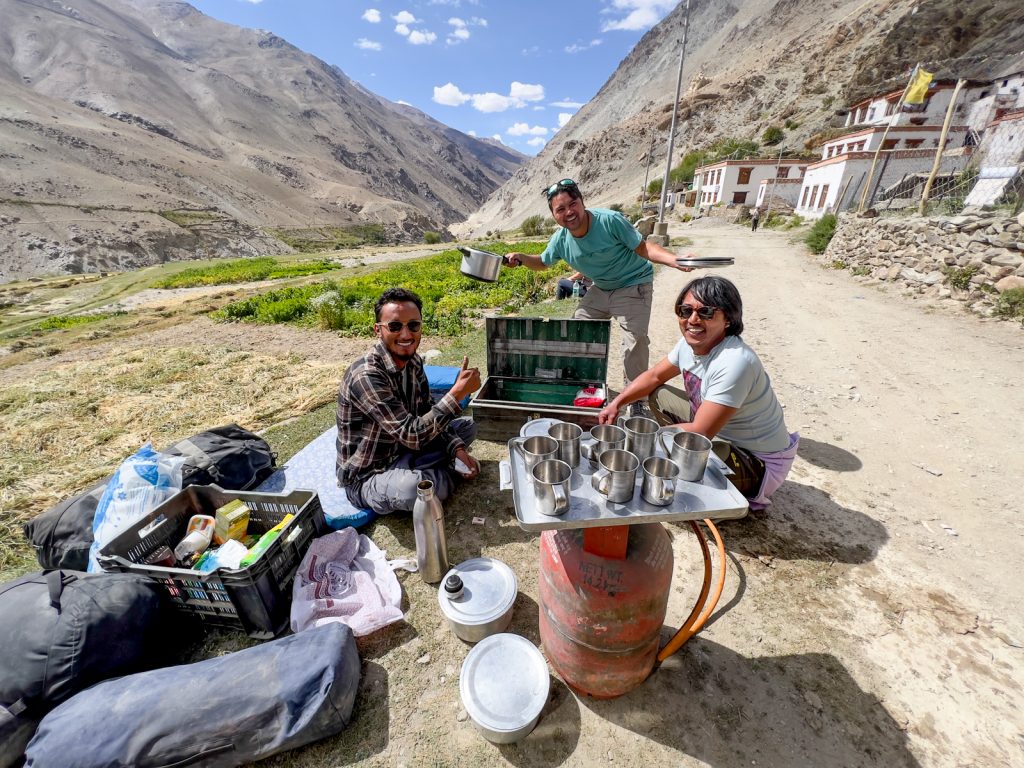
Guide KC, driver Thinles and assistant guide Gyaltson cooking up one of many delicious picnic lunches during our journey!! What a fabulous trip, thanks to these guys especially! (image by Julie-Anne Davies)

























































